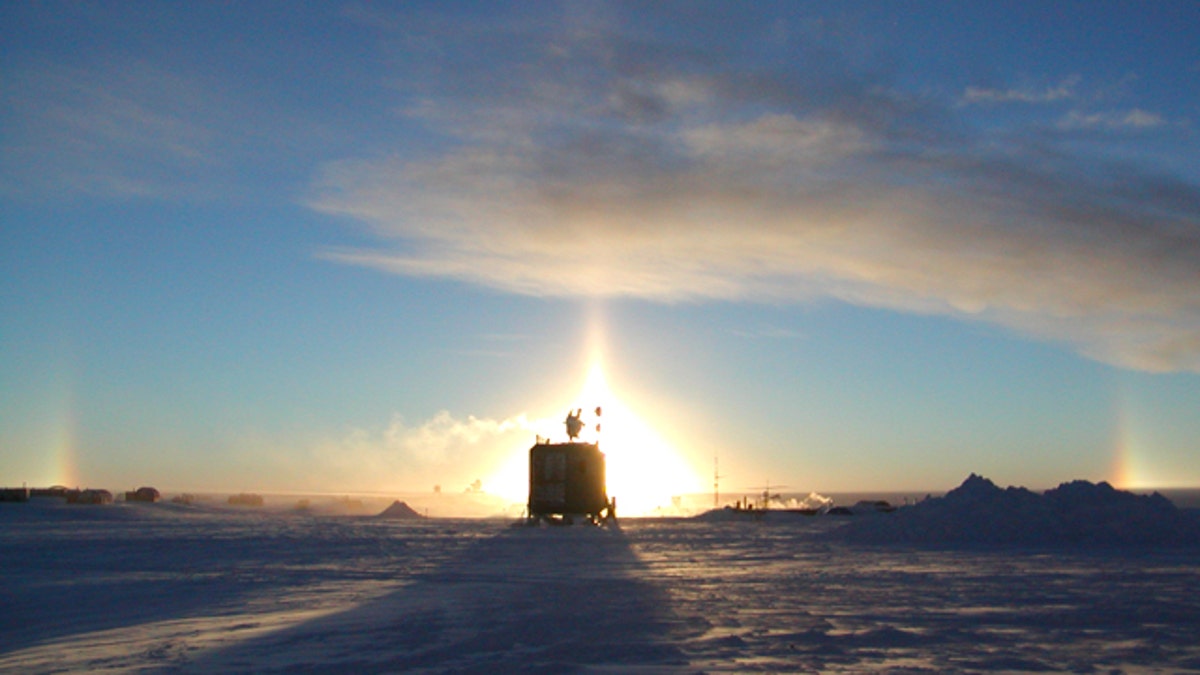
(NSF)
Like exploding stars, black holes, dark matter? How about cosmic intrigue, deep space astronomy, or origins of the universe?
Then you’re gonna love this.
Researchers at the University of Wisconsin are putting the finishing touches on a giant underground telescope buried beneath the South Pole to help understand said phenomena. Accordingly called the IceCube Neutrino Observatory, completion is expected to occur at 8 p.m. CST, once the last of more than 5,000 optical sensors is buried as much as two miles below the permanent ice cap covering Antarctica.
The sensors are buried across one cubic kilometer of Antarctica's frozen tundra; weight-wise, that's a gigaton of ice.
Just what exactly will this telescope observe? Tiny subatomic particles called neutrinos: They’re like a neutron, in that they hold no charge, but they’re the size of an electron. Neutrinos are important because they’re the byproduct of nuclear reactions, meaning if you retrace them to their origins, you could happen upon some interesting things.
“The goal is to record interactions of high-energy neutrinos that travel through the cosmos and stop in the ultra-transparent natural ice of Antarctica,” said researcher Francis Halzen in an interview with FoxNews.com from his cold base at the South Pole. “We hope to detect extremely high energy neutrinos that point back to active galaxies, gamma-ray bursts, supernova remnants in our Galaxy -- or possibly, unanticipated cosmological events.”
Not only that, but the planned 15-year experiment also hopes to identify new sources of cosmic energy, Halzen said.
“The detection of these neutrinos will resolve the century-old question of the origin of cosmic rays,” he told FoxNews.com. Space is mysterious, too. “Other missions include the search for dark matter and for supernova explosions inside our own Galaxy. It is however a discovery instrument, and surprises are what we really hope for.”
Given the harsh conditions, construction of the observatory, which began in 2005, has understandably been an arduous task. Workers have been able to work only three to four months out of the year, since the remaining months “enjoy” outside temperatures that reach upwards of negative 100 degrees F.
Funded by the National Science Foundation with an endowment of $272 million, IceCube is located in the heart of the Antarctica for calculated reasons.
“The South Pole presented two important conditions,” Halzen explained. “A layer of almost 3 kilometers of optically transparent deep ice and the infrastructure of the Amundsen Scott South Pole Station, maintained by the National Science Foundation.”
Since commonly-known particles are more easily absorbed, the ice is ideal for capturing neutrinos “on film” if you will. The Antarctic ice also neutralizes telescopic pollution better than most places, so the fast-moving neutrinos can be traced by the sensors. “Looking through the Earth, we reduce the background of particles other than neutrinos,” Halzen said.
As for the neutrinos, they're so tiny and lightning fast that they can pass through solid matter without colliding with any molecules, Halzen explained. Humans included. (I think I just felt one go through me.) What’s more, the little buggers travel in perfectly straight lines and on rare occasions crash into atoms of ice, which enables Halzen and his team to work their way backwards towards scientific discovery.
“From deep within the ice, the telescope will observe the full sky, both northern and southern hemispheres simultaneously all the time,” Halzen told FoxNews.com. “We do not have to point the telescope.”
One of the scientists associated with the project described the sensors as basically light bulbs in reverse, that pick up light and send an electrical signal to the high-powered computer within them. Burying them in the ice is its own challenge; as you might expect, the team employs hot water drills to penetrate the South Pole's ice.
"Hot water drilling is an art. It is an incredible art; almost not a science, almost not engineering," Halzen said earlier this year. "It's just difficult; it's a choreography, which has to work perfectly, and the people learned this very fast."
Construction completion is scheduled for late Friday night, but the telescope won't be ready to peer into the depths of the universe for another few months, said Laurel Bacque, communications manager for UW's IceCube Research Center.
"True operational completeness will not occur until March 2011, when the new strings have frozen over and been integrated in the system," she told FoxNews.com.
Noting that a “warm” day in Antarctica is around 0°, what exactly would drive scientists to endure such extremes?
“The basic motivation is to understand our universe,” Halzen concluded. “The stuff from which we are made is only 4% of the universe's inventory. These are motivations dominantly driven by curiosity; by the dream of mankind to understand our origins, our place in the cosmos, and a far future much beyond our human horizons.”
Blake Snow is a freelance journalist living in Utah with his wife and children. Suggestion box and contact information can be found on his website.
